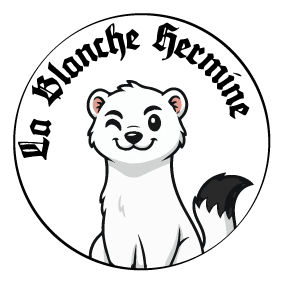Introduction
La Blanche Hermine is a workshop located in Brittany and specialized in historical art, in particular in the Celtic & medieval fields (illumination, calligraphy and heraldry in particular).
Its work is above all based on research in historical sources (manuscript, map, sculpture/engraving, etc.) to offer authentic patterns of historical and/or symbolic dimension, as well as creations on these themes.
Aztec codices, Buddhist thangkas or Japanese fabrics are also explored to present arts and spiritualities of the world.
Company
La Blanche Hermine is the commercial brand of a company governed by a micro-enterprise.
Its French registration numbers (SIREN & SIRET) are deposited.
Its French activity code (APE) is: 7410Z (specialized design activities).
The images, logos and patterns of La Blanche Hermine articles are wholly or partly inspired by historical elements (manuscript, coin, engraving, etc.), original creations, illustrations with the explicit agreement of their respective authors, under license CC/GNU except non-commercial use, or public domain (art. L123-1 of the French Code of the intellectual property).
This website has no relation to the excellent song by Gilles Servat.
Address
La Blanche Hermine
7 rue Isole
F29300 Quimperlé
France
Contact us
Tel: +33 6 51 66 60 90
Mail: bijou@lablanchehermine.bzh
Shop opening hours
The opening hours of the workshop and its physical store vary according to the tourist season.
For a particular order or the receipt of an order, the workshop can be open to you by appointment during the closing periods.
You can either send us a message (SMS or email) or visit the Facebook page of La Blanche Hermine:
https://www.facebook.com/LaBlancheHermineBZH
The schedules on La Blanche Hermine Google page are always updated.
Do not hesitate to check this page for reliable information.
Official references
As proof of the seriousness of its activity, La Blanche Hermine is proud to quote the references of public organizations.
Since 2019, La Blanche Hermine has been quoted in "Quimperlé artists' trail" published by the municipality of Quimperlé.
Read Quimperlé artists'trail 2023 (in French) online.
Also since 2019 to 2021, La Blanche Hermine is referenced by the Quimperlé Terre Océane Tourist Office.
This referencing involves regular visits from the staff of the organization and is a guarantee of seriousness and quality on our part, and a real interest for tourists.
In this short video, the Tourist Office wanted to focus on our work on historical sources, Celtic in particular,
which is normal as we are in Brittany.
In addition, La Blanche Hermine is also referenced by the Finistère 360° agency of the Département, better known by its brand "Tout commence en Finistère" (Everything begins in Finistère), on page (links in French only):
- Boutiques & designers: our good addresses in Quimperlé
About the stoat (or ermine)...
Note: We name stoat the animal, and ermine its white fur.
The animal
The stoat is a carnivorous mammal of about thirty centimeters, with a tail of about ten centimeters.
During spring and summer, its coat is brown above, white below.
In fall and winter, it turns completely white, except for the tip of the tail, which remains black.
The whiteness of its fur will make it a very sought-after animal in winter to feed the nobility and the high clergy to ornament their ceremonial adornments. Fortunately, today rabbit or faux fur is prefered ...
The stoat's natural development area covers the entire northern hemisphere with oceanic or continental climates. It evolves in mid-mountain region, or in hedgerows at lower altitude.
A stoat can kill a rabbit 10 times its size!
(BBC documentary)
Its menu is mainly composed of rodents, even larger than it like rabbits, even birds or amphibians.
It does not dig burrows, but borrows those of its former prey whose fur will warm its babies born in April.
Its name comes from the Latin armenius mus, rat or mouse from Armenia.
It is related to weasels, ferrets and polecats.
The ermine hypnotizes its prey!
(National Geographic documentary)
A symbol
It is not a mystery for anyone, the ermine is one of the major symbols of Brittany, even THE main symbol. Paradoxically, this symbol is less the animal than the ermine spots used in heraldry and that we find in particular on the Gwenn ha du (the flag of Brittany) and now on almost all types of objects claiming to be of Breton origin.
As a reminder, ermine spots are the stylization of the black part of the tail sewn to the rest of the fur assembled by three black leather threads.
Artists are particularly creative in representing the stylized spots, to the point where we come to forget both the animal and the royal luxury of its fur or the symbol of purity ...
Before embarking on any study of the history of the ermine, it is imperative to remember that any explanation is at best hypothetical, if not within the province of legend. Too few traces are left in the archives, even though there may be a bundle of presumptions.
The legend of the Duchess Ann of Brittany
The Duchess Ann was crossing her lands one day, when she saw two peasants chasing a white stoat. In its race, the animal found itself facing a huge pool of mud that it could not get around. So, rather than defiling its white coat, the stoat turned to face the two hunters.
The Duchess was very impressed by the courage shown by the small animal and decided to adopt the motto "Rather death than defilement", Kentoc'h mervel eget bezañ saotrett in Breton.
However, history does not say if the Duchess Ann interceded in favor of the white stoat ...
There are many variations of this legend, including one, more likely, featuring Duke John III the Good.
